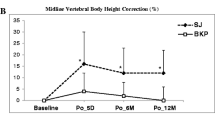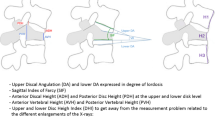Abstract
Purpose
Balloon kyphoplasty (BK) has emerged as a popular method for treating osteoporosis vertebral compression fractures (OVCFs). In response to several shortcomings of BK, alternative methods have been introduced, among which is radiofrequency kyphoplasty (RFK). Biomechanical comparisons of BK and RFK are very sparse. The purpose of this study was to perform a biomechanical study in which BK and RFK are compared.
Methods
Each of the two study groups comprised six specimens prepared from two functional spinal units (FSUs) cut from fresh-frozen cadaveric spines (3 of T9–T11 and 3 of T12–L2). VCFs (A1.2 type) were created in the middle VB of each of the FSUs, with a height loss of 30% of the VB. After that, the specimens were subjected to cyclic compression–compression loading. The following parameters were determined: range of motion (ROM), height of the middle VB, augmentation time, cement interdigitation and cement distribution. Also, the cement layer, the trabecular bone in the augmented VB and the bone–cement interface were examined for cracks. All of these parameters were determined at various stages, namely in the intact middle VB and after its fracture, cement augmentation and subject to the cyclic loading protocol.
Results
Fractures caused a significant increase in median ROM and a significant reduction in the height of fractured VB. Cement augmentation significantly stabilized the fractures and led to partial height restoration. ROM and vertebral height, however, were not restored to the intact levels. Cyclic loading led to a further significant increase in ROM and a significant height reduction. There were no significant differences between BK and RFK in terms of any of these parameters.
Conclusions
BK and RFK achieved similar results for fracture stabilization and restoration of the height of the fractured VB. RFK involved shorter cement augmentation time and less damage to the trabecular bone.






Similar content being viewed by others
References
Boonen S, Wahl DA, Nauroy L et al (2011) Balloon kyphoplasty and vertebroplasty in the management of vertebral compression fractures. Osteoporos Int 12(2915):2934
Garfin SR, Yuan HA, Reiley MA (2001) New technologies in spine: kyphoplasty and vertebroplasty for the treatment of painful osteoporotic compression fractures. Spine 26(14):1511–1515
Hillmeier J (2010) Balloon kyphoplasty. Orthopade 39(7):665–672
Kyphon. http://www.kyphon.com/. Accessed on 27 Jan 2011
Kettler A, Schmoelz W, Shezifi Y et al (2006) Biomechanical performance of the new BeadEx implant in the treatment of osteoporotic vertebral body compression fractures: restoration and maintenance of height and stability. Clin Biomech (Bristol, Avon) 21(7):676–682
Wilke HJ, Mehnert U, Claes LE, Bierschneider MM, Jaksche H, Boszczyk BM (2006) Biomechanical evaluation of vertebroplasty and kyphoplasty with polymethyl methacrylate or calcium phosphate cement under cyclic loading. Spine 31(25):2934–2941
Wilke HJ, Claes L, Schmitt H, Wolf S (1994) A universal spine tester for in vitro experiments with muscle force simulation. Eur Spine J 3(2):91–97
Wilke HJ, Wenger K, Claes L (1998) Testing criteria for spinal implants: recommendations for the standardization of in vitro stability testing of spinal implants. Eur Spine J 7(2):148–154
Ruger M, Schmoelz W (2009) Vertebroplasty with high-viscosity polymethylmethacrylate cement facilitates vertebral body restoration in vitro. Spine 34(24):2619–2625
Wilson DR, Myers ER, Mathis JM et al (2000) Effect of augmentation on the mechanics of vertebral wedge fractures. Spine 25(2):158–165
Kim MJ, Lindsey DP, Hannibal M, Alamin TF (2006) Vertebroplasty versus kyphoplasty: biomechanical behavior under repetitive loading conditions. Spine 31(18):2079–2084
Yuan HA, Brown CW, Phillips FM (2004) Osteoporotic spinal deformity: a biomechanical rationale for the clinical consequences and treatment of vertebral body compression fractures. J Spinal Disord Tech 17(3):236–242
Dalton BE, Kohm AW, Poser RD (2011) Comparison of targeted vertebral augmentation technique (TVA) versus balloon kyphoplasty in an ex vivo vertebral compression fracture model. GRIBOI, Boston
Dabirrahmani D, Becker S, Hogg M, Appleyard R, Baroud G, Gillies M (2011) Mechanical variables affecting balloon kyphoplasty outcome—a finite element study. Comput Methods Biomech Biomed Eng 15:211–220
Steinmann J, Tingey CT, Cruz G, Dai Q (2005) Biomechanical comparison of unipedicular versus bipedicular kyphoplasty. Spine 30(2):201–205
Tohmeh AG, Mathis JM, Fenton DC, Levine AM, Belkoff SM (1999) Biomechanical efficacy of unipedicular versus bipedicular vertebroplasty for the management of osteoporotic compression fractures. Spine. 24(17):1772–1776
Rohlmann A, Boustani HN, Bergmann G, Zander T (2010) A probabilistic finite element analysis of the stresses in the augmented vertebral body after vertebroplasty. Eur Spine J 19(9):1585–1595
Song BK, Eun JP, Oh YM (2009) Clinical and radiological comparison of unipedicular versus bipedicular balloon kyphoplasty for the treatment of vertebral compression fractures. Osteoporos Int 20(10):1717–1723
Liu JT, Liao WJ, Tan WC et al (2010) Balloon kyphoplasty versus vertebroplasty for treatment of osteoporotic vertebral compression fracture: a prospective, comparative, and randomized clinical study. Osteoporos Int 21(2):359–364
Wilke HJ, Jungkunz B, Wenger K, Claes LE (1998) Spinal segment range of motion as a function of in vitro test conditions: effects of exposure period, accumulated cycles, angular-deformation rate, and moisture condition. Anat Rec 251(1):15–19
Panjabi MM, Krag M, Summers D, Videman T (1985) Biomechanical time-tolerance of fresh cadaveric human spine specimens. J Orthop Res 3(3):292–300
Smeathers JE, Joanes DN (1988) Dynamic compressive properties of human lumbar intervertebral joints: a comparison between fresh and thawed specimens. J Biomech 21(5):425–433
McKiernan F, Jensen R, Faciszewski T (2003) The dynamic mobility of vertebral compression fractures. J Bone Miner Res 18(1):24–29
Belkoff SM, Mathis JM, Fenton DC, Scribner RM, Reiley ME, Talmadge K (2001) An ex vivo biomechanical evaluation of an inflatable bone tamp used in the treatment of compression fracture. Spine. 26(2):151–156
Meeder PJ, DaFonseca K, Hillmeier J, Grafe I, Noeldge G, Kasperk C (2003) Kyphoplasty and vertebroplasty in fractures in the elderly: effort and effect. Chirurg 74(11):994–999
Berlemann U, Franz T, Orler R, Heini PF (2004) Kyphoplasty for treatment of osteoporotic vertebral fractures: a prospective non-randomized study. Eur Spine J 13(6):496–501
Voggenreiter G, Brocker K, Rohrl B, Sadick M, Obertacke U (2008) Results of balloon kyphoplasty in the treatment of osteoporotic vertebral compression fractures. Unfallchirurg. 111(6):403–412
Belkoff SM, Mathis JM, Jasper LE (2002) Ex vivo biomechanical comparison of hydroxyapatite and polymethylmethacrylate cements for use with vertebroplasty. AJNR Am J Neuroradiol 23(10):1647–1651
Belkoff SM, Jasper LE, Stevens SS (2002) An ex vivo evaluation of an inflatable bone tamp used to reduce fractures within vertebral bodies under load. Spine. 27(15):1640–1643
Alkalay RN, von Stechow D, Torres K, Hassan S, Sommerich R, Zurakowski D (2008) The effect of cement augmentation on the geometry and structural response of recovered osteopenic vertebrae: an anterior-wedge fracture model. Spine. 33(15):1627–1636
Perry A, Mahar A, Massie J, Arrieta N, Garfin S, Kim C (2005) Biomechanical evaluation of kyphoplasty with calcium sulfate cement in a cadaveric osteoporotic vertebral compression fracture model. Spine J. 5(5):489–493
Acknowledgements
We thank Michael Denoix and Christian Liebsch for assistance in preparing and performing the biomechanical tests, Renate Ihler for her technical assistance and Dr. Annette Kienle for making available to us the jig for cement augmentation; the technicians and other staff members of the Department of Radiology at the German Armed Forces Hospital Ulm, Germany; Medtronic for material support; and DFine, for financial and material support.
Author information
Authors and Affiliations
Corresponding author
Ethics declarations
Conflict of interest
None of the authors has any potential conflict of interest.
Financial support
This research was conducted with financial support from DFine© Europe (Mannheim, Germany) and material support from Medtronic© (Meerbusch, Germany).
Rights and permissions
About this article
Cite this article
Achatz, G., Riesner, HJ., Friemert, B. et al. Biomechanical in vitro comparison of radiofrequency kyphoplasty and balloon kyphoplasty. Eur Spine J 26, 3225–3234 (2017). https://doi.org/10.1007/s00586-017-5035-5
Received:
Revised:
Accepted:
Published:
Issue Date:
DOI: https://doi.org/10.1007/s00586-017-5035-5




